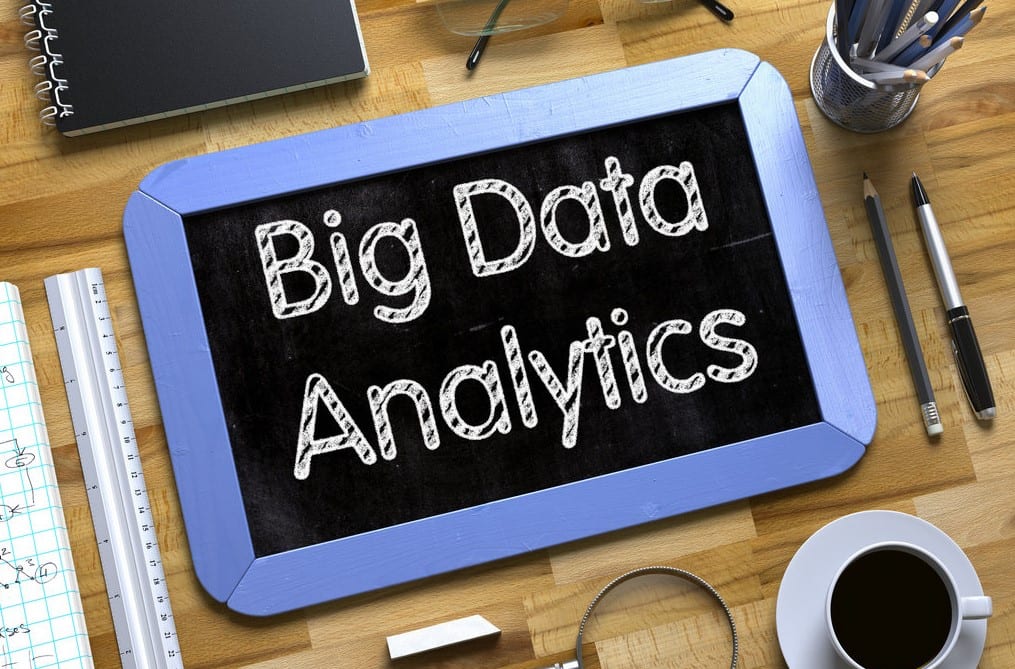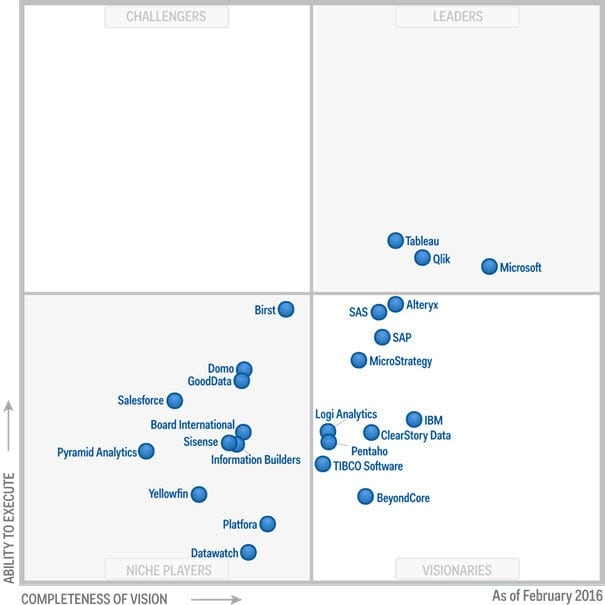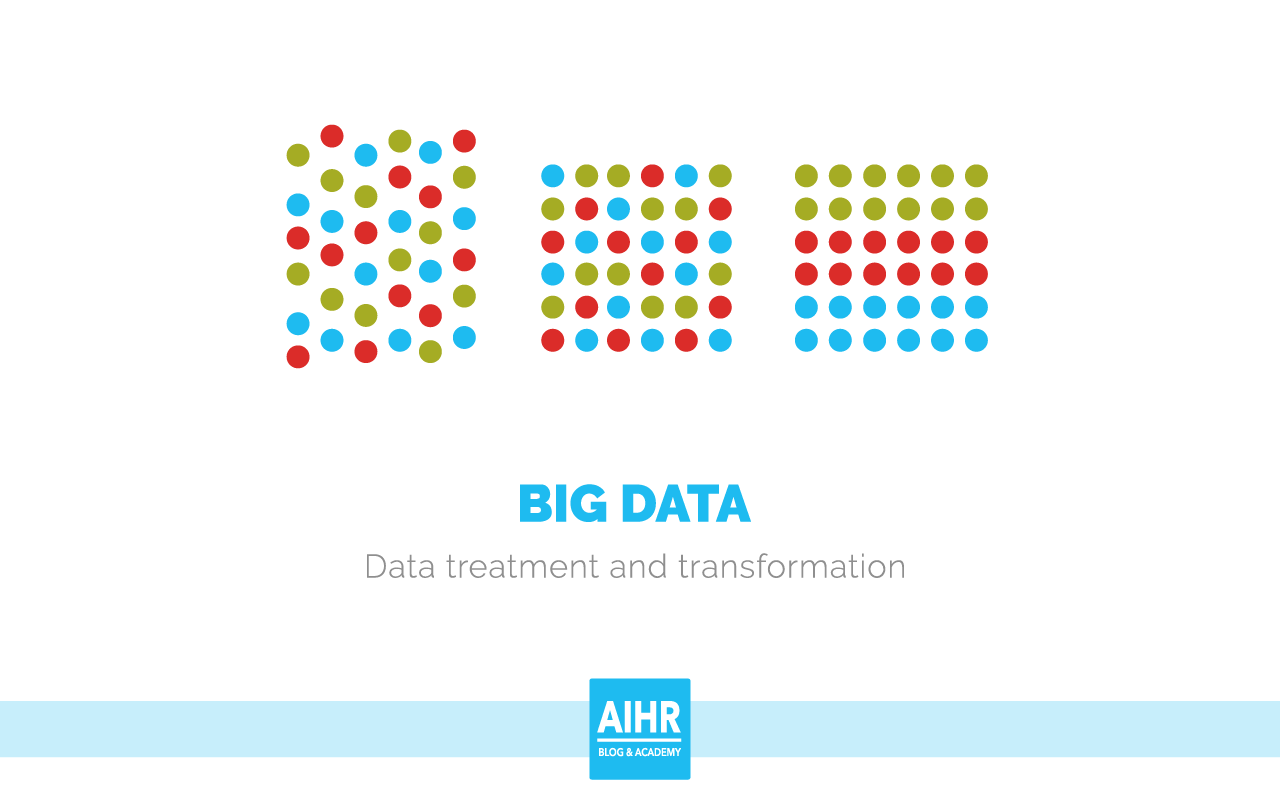Big data, business intelligence, and HR analytics: How are they related?

Big data, business intelligence, and HR analytics are three buzzwords that are frequently talked about. Do you really know what they mean? And what added value does big data and business intelligence bring to the field of HR? This article will explain everything you need to know to answer these questions using different examples.
Big data
What is big data?
Big data is traditionally characterized by four elements, also called the four V’s.
- Volume: Big Data needs to be big. And we mean really big. We’re not talking about gigabytes, we are talking about terabytes and petabytes. The ‘big’ in big data represents millions and millions of cells in your Excel sheet. In fact, it’s often so large that it wouldn’t even fit in Excel in the first place.
- Velocity: Big data is not static, it has a certain momentum. It is constantly collecting new data. Take twitter data as an example: large amounts of data represent hundreds of tweets and retweets a second.
- Variety: Big data has a certain variety. We are not only talking about nicely structured data (data that’s ordered in neat columns and rows). We are also talking about unstructured data (like the data in your average email).
- Veracity: Big data is messy and can’t always be trusted. Quality and accuracy are not always present in a large data. Data cleaning is part of the process of analyzing big data. However, because of the large quantity of data some of these little errors can be nullified. The large quantity of data thus makes up for the decrease in reliability of individual data points.
Bernard Marr adds a fifth V: Value. Having access to big data is no good unless you can turn it into value!
How big data applies to HR
There are different opinions about whether big data really applies to HR. The simple answer is: it does.
However, the more nuanced answer is: it depends. There’s a reason why HR professionals are not really data-savvy: the amount of data they work with is limited. Let’s see what HR data looks like when taking McKinsey’s and Marr’s five V’s for big data into account:
- HR has access to a large variety of data. Systems containing employee data, pay information, engagement scores etc. are all examples of structured data. Things like performance reviews and email content can contain interesting information for analysis – and they are oftentimes unstructured.
- In terms of veracity, HR data is often quite messy and unreliable. Data like someone’s career history within the organization is often missing: the old date is simply over written. In addition, numerous reorganizations and restructuring efforts make it hard to keep track of how long someone stayed in a function. An example: How do you know that someone has kept the same responsibilities when his job’s function title has changed two times in the last 3 years?
- Overall, the volume of data in HR is quite low. I haven’t seen a large database with employee records exceed a few gigabytes. This is not necessarily a bad thing but it makes HR data the exception. Usually big data is… bigger. However, for the average HR professional, a few gigabytes of data is already quite something!
- The velocity of data in HR is also quite low. HR data is generally quite static. Records are only changed when someone switches functions or when different departments are shuffled. Other than that, the data remains mostly static.
- HR data most definitely holds value. When leveraged the right way it can be used to uncover workforce risks, make better people decisions and help in building a competitive advantage for the firm.
Does big data apply to HR?
Again, I think it does. HR analytics is a way to generate valuable insights into the workforce. This can be done through the use of datasets that are larger than most HR professionals have ever worked with. That is the essence of big data in HR.
Examples of big data in HR
Let’s take Natural Language Processing and combine this with HR. Most HR departments are sitting on large piles of unanalyzed, written performance reviews. You can use Natural Language Processing to analyze these reviews to create employee competency profiles or automatically generate performance scores for both employees and managers.
You can also use this to, for example, do a sentiment analysis in email traffic. Can you measure engagement through analysis of email messages? This is tricky to do but could yield very interesting people insights.
Keencorp is an example of an organization that has been doing this for the past few years. They claim to be able to predict employee’s engagement and attitudes in different groups by scanning email data.
Relationship of big data with HR analytics
Whenever we talk about predicting employee turnover or the number of HR self-service tickets to optimize handling time we are working with large quantities of data that help us generate new workforce insights. This means that big (HR) data is the input for HR analytics.
Business intelligence
What is business intelligence?
According to Gartner, business intelligence is an umbrella term that includes the application, infrastructure and tools, and best practices that enable access to and analysis of information to improve and optimize decisions and performance.
Organizational data is often stored in different, separate systems. These systems do not communicate with each other. This means that your sales data is not normally combined with your inventory data or your site visitors.
Tools combining this data can show you which customers actually bought something (combining site data with sales data), or what items sell best (combining inventory with sales data). These are great examples of business intelligence tools.
How business intelligence applies to HR
Similar to our sales example, business intelligence can also be used for HR data. Your Applicant Tracking System and your performance management system are usually not combined. This prevents you from analyzing which hires perform best.
Business intelligence (BI) tools (see the example below) can help you combine this data. After combining this data, it will be much easier to do three things.
- Aggregating data: Most HR reporting consists of ad-hoc reporting. Different extracts are manually combined. BI tools help in the aggregation of data and enable automated reporting.
- Visualizing data: Most HR systems are transactional systems that generate transactional data. Transaction data describe an event using a time dimension and a value which refers to one or more objects. See the example below: the candidate is hired on a certain date and the employee’s contract is terminated on a certain date. Both actions are recorded as separate entries (transactions) in the system.
These systems are build to keep records, not to report or visualize data. BI tools are really good at aggregating data from multiple systems and visualizing it. - Analyze data: The final step is data analytics. BI tools are much better at analyzing data than your average HR-system. Examples are Power BI and SAS. They enable you to statistically analyze large quantities of data.
In short, BI tools are made to aggregate, visualize, analyze, and report data. In the clip below, you will find a brief explanation of the difference between BI and people analytics.
Examples of Business intelligence tools
A few of the best known BI tools in HR are Qlik, Visier, Tableau, and Power BI.
- Visier brands itself as a workforce analytics solution with a similar application. It aggregates data from various systems and helps in the analysis of this data.
- Qlik and Tableau both brand themselves as data visualization tools that serves as connectors to all your information systems.
- Microsoft’s Power BI will feel more natural to analysts who are used to working in Excel. Power BI is particularly useful when a lot of your reporting happens in Excel. We included Power BI in our HR analyst course as it is easy to use. Check out the course if you haven’t already!

Relationship of big data with HR analytics
A lot of the business intelligence tools do what most people refer to as HR analytics. However, in reality, this is slightly more complicated.
BI tools in HR are very good at connecting different systems, visualizing data and assisting in reporting on this data.
However, these tools are not so good in doing actual data analytics (the real HR analytics). Software packages that specialize in doing these analytics, like SPSS and R do this much better. If you’re interested to read more about these and other tools, check our overview of the 5 top HR analytics tools.
Technically, these tools could fit into the ‘business intelligence’ category. They are, however, usually seen as stand-alone tools.
This is because the analytics process requires a well-defined research question that is specific to the organization’s context, culture and data quirks. This is very hard to automate in a BI system – and that’s why the real analyses in HR are done manually by data experts.
HR analytics
What is HR analytics?
HR analytics is the systematic identification and quantification of people drivers of business outcomes. In other words, it is a data-driven approach towards Human Resource Management.
HR analytics enables us to give an answer to questions like:
- What will my turnover be next year?
- How much of my employee turnover consists of regretted loss?
- How can I optimize staffing levels for our HR self-service customer tickets?
- What factors drive employee turnover?
- What are my biggest workforce risks?
- Et cetera
I can go on and on about HR analytics but for more details, you are better off reading our blog What is HR analytics?
How it is applied in HR
Examples of HR analytics include Keencorp and predictive employee turnover analytics. A great overview of applications of predictive analytics in HR can be found here.
How HR analytics relates to big data and business intelligence
As you understand now, big data and business intelligence are generic business terms. Applied to HR, they form the basics of HR data analytics.
There is some discussion about whether the slice-and-dice kind of analyses that characterize a lot of business intelligence applications falls into the HR analytics category. Some experts claim that the term HR analytics should only be used when we talk about advanced analytics, like the more complicated predictive analytics.
Others, including myself, have a broader definition of HR analytics: HR analytics is data-driven people management. I think BI applications are a fundamental part of HR analytics as it will help to connect data sources and generates insights for HR professionals through integrated reporting on HR data.
Conclusion
This review on how big data and business intelligence relate to HR analytics turned out longer than expected. But that’s no problem, it’s important to know the difference between the different terms.
Even though these terms are oftentimes used as buzz words, you can now define how they can add value to your organization. Big data, business intelligence, and HR analytics are all part of one big family: a more data-driven approach to Human Resource Management!
Weekly update
Stay up-to-date with the latest news, trends, and resources in HR
Learn more
Related articles
Are you ready for the future of HR?
Learn modern and relevant HR skills, online














